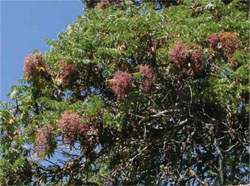38.2.2 Clinical manifestations, diagnosis and treatment of taeniasis
Generally, people live with relatively few symptoms even with a large tapeworm inside them. They may experience discomfort around the anus when proglottids are discharged, and diagnosis is made on the basis of seeing the flat white proglottids wriggling in the stools. Mild abdominal pain or discomfort, nausea, change in appetite, weakness, and weight loss can also occur with Taenia saginata infection.
Traditionally, people with tapeworm in Ethiopia self-treat with extracts of kosso – the Amharic name for a slender flowering tree (species name Hagenia abissinica, Figure 38.7), or enkoko – the scarlet fruits of the climbing shrub (Embelia schimperi), both of which have proven taenicidal properties.(Taenicidal refers to any treatment that kills tapeworms; it is pronounced ‘teen-ih-side-ull’). Medical treatment is to give a single dose of praziquantel (one 10 mg tablet for every kilogram of the patient’s body weight), which is highly effective at killing tapeworms. You are not expected to prescribe praziquantel, which is given at a health centre.

Which other communicable disease have you learned about in this Module, which is treated with praziquantel?
Schistosomiasis is also treated with praziquantel, but at a much higher dosage (40 to 60 mg/kg, given in two or three doses during a single day – see Study Session 37, Section 37.1.4).
38.2.1 Mode of transmission of taeniasis
